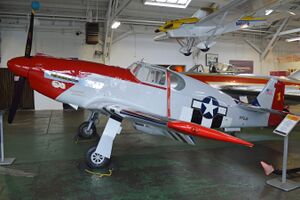Engineering:Jurca Gnatsum
| Jurca MJ-7 Gnatsum | |
|---|---|

| |
| Role | Homebuilt near scale replica warbird |
| National origin | France |
| Designer | Marcel Jurca |
| First flight | 1969 |
| Number built | 25+ |
| Variants | Falconar SAL Mustang |
The Jurca Gnatsum is a French homebuilt near scale replica aircraft based on the North American P-51 Mustang.[1]
Design & Development
The Gnatsum (Mustang spelled backwards) is one of many wooden homebuilt designs from Romanian designer Marcel Jurca. Jurca, a Henschel Hs 129 pilot in World War II, expanded his warbird replica designs to include the Allied North American P-51 Mustang fighter.[2]
The Gnatsum is a low-wing, cantilever monoplane with an enclosed single-seat cockpit and manually retractable tailwheel landing gear based on that of the Jurca Sirocco.[3] Suitable for a number of engines around 200 hp (149 kW), plans for the Gnatsum are available as the 2/3 scale MJ-7 and the 3/4 scale MJ-77, as well as the MJ-70 full-size representation. All versions are constructed from wood with fabric covering, and manufacturing rights to the kit aircraft were acquired by Falconar Avia.[4] Plans for the MJ-77 are available from Avions Marcel Jurca.[5]
Some of the engines suitable for the MJ-7 Gnatsum series are:-
- 200 hp (149 kW) Ranger 6-440C-5 inline engine
- 125 hp (93 kW) Menasco C4
- 130 hp (97 kW) de Havilland Gipsy Major I
- 125 to 160 hp (93 to 119 kW) Rambler aluminum block in-line 6
- General Motors aluminum V-8
Variants
- MJ-7
- 2/3 scale variant
- MJ-7S Solo
- Single-seat advanced trainer version of MJ-7, the under-belly scoop inherited from the Mustang design was removed.
- MJ-77
- 3/4 scale Mustang variant that requires an engine of 250 to 600 hp (186 to 447 kW).[6][7]
- MJ-70
- Full-scale variant (still under development in 2001 when Jurca died - never completed)
Specifications (Jurca MJ-77 Gnatsum)
Data from [8]
General characteristics
- Crew: 1 Pilot
- Capacity: 1 (small) passenger
- Length: 6.53 m (21 ft 5 in)
- Wingspan: 8.43 m (27 ft 8 in)
- Wing area: 13.5 m2 (145 sq ft)
- Empty weight: 998 kg (2,200 lb)
- Gross weight: 1,297 kg (2,860 lb)
- Fuel capacity: 50 U.S. gallons (190 L; 42 imp gal)
- Powerplant: 1 × Geschwender , 260 kW (350 hp)
- Propellers: 4-bladed
Performance
- Maximum speed: 465 km/h (289 mph, 251 kn)
- Cruise speed: 370 km/h (230 mph, 200 kn)
- Stall speed: 105 km/h (65 mph, 56 kn)
- Range: 800 km (500 mi, 430 nmi)
- Rate of climb: 7.6 m/s (1,500 ft/min)
See also
- North American Mustang
Aircraft of comparable role, configuration and era
- Bonsall DB-1 Mustang
- FK-Lightplanes SW51 Mustang
- Linn Mini Mustang
- Papa 51 Thunder Mustang
- Stewart S-51D Mustang
- Titan T-51 Mustang
- W.A.R. P-51 Mustang
References
- ↑ "All these planes you can build from plans". Popular Science: 99. June 1970.
- ↑ Nick Stasinos (February 1972). "Marcel's Mini Fighters". Plane & Pilot.
- ↑ Sport Aviation: 35. Aug 1965.
- ↑ Air Trails: 59. Summer 1971.
- ↑ "Ordering Jurca Plans". http://www.marcel-jurca.com/index.php/en-us/drawings. Retrieved 22 October 2019.
- ↑ Bayerl, Robby; Martin Berkemeier; et al: World Directory of Leisure Aviation 2011-12, page 94. WDLA UK, Lancaster UK, 2011. ISSN 1368-485X
- ↑ Tacke, Willi; Marino Boric; et al: World Directory of Light Aviation 2015-16, page 100. Flying Pages Europe SARL, 2015. ISSN 1368-485X
- ↑ "Jurca M.J-77 Mustang (75%)". Pilotfriend.com. http://www.pilotfriend.com/experimental/acft3/91.htm. Retrieved 2012-09-26.
- Taylor, Michael J. H. (1989). Jane's Encyclopedia of Aviation. London: Studio Editions. p. 547.
- Janes.com
- Marcel Jurca old website
- www.aircraftworlddirectory.com
External links
 |

